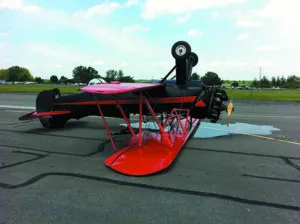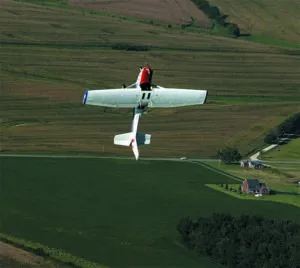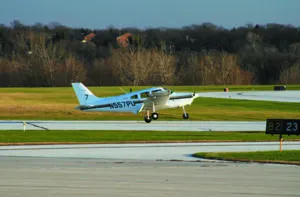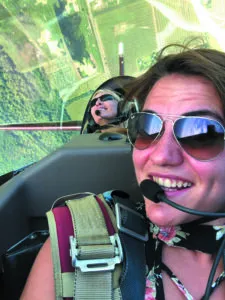We’re good pilots—by and large. Getting our certificates and ratings wasn’t easy. Face it, we sweat blood training to master the skills, knowledge and judgment needed to cause an inanimate object to rise into an often unforgiving sky and return to the planet not only safely, but with some degree of panache.
In the process of achieving a level of mastery of aeronautical maneuvering we often—but not always—avoid disaster through the quick thinking and skills of the flight instructor in the other seat. Once the safety net of the CFI is withdrawn we begin to discover, sometimes painfully, that piloting skills erode—with distressing speed. Which is why the NTSB continues to report that the most common cause of general aviation accidents—fatal and non—is loss of control (LOC).
To add insult to that injury, the NTSB finds that in almost 100 percent of LOC accidents the PIC either started the loss of control through his actions or could have broken the chain leading to the crash with appropriate control inputs.
If that’s not a plea for pilots to take recurrent training in basic piloting skills, we’ve never heard one.
After all, at some point in her career, every pilot demonstrated the ability to make crosswind landings, go-arounds, recover from unusual attitudes/upsets and generally do what was necessary to return an aircraft to earth within a few feet of the desired location and then get it to a tiedown without causing structural damage. To us, that means that, unless that pilot has suffered the onset of illness that has significantly diminished her physical or mental abilities, some training designed for loss of control prevention and/or recovery will return that pilot to a proficiency level satisfactory to avoid becoming the central character in an NTSB report.
Upset Recovery Training
The FAA’s definition of upset is a good place to start a discussion on upset recovery—it’s when the flight attitude or airspeed of an aircraft is outside of the normal bounds for which the aircraft is designed.
Dealing with inflight LOC (LOC-I) is the purpose of dedicated upset recovery training courses. In short, they teach how upsets/LOC-I most often come about (and how to recognize that the situation is developing and stop the development); the almost paralyzing startle reaction when an upset occurs; and how to recover from the upset without hitting the ground or breaking the airplane.
As an aside, we believe that the term “startle” is a far too prosaic word for the adrenaline-soaked terror generated by a sudden loss of control event—especially when the windshield seems filled with a view of the ground—and how the terror can dramatically inhibit a pilot’s ability to respond correctly, or even at all.
That’s why we train.
We’ll make clear up front that upset recovery training and aerobatic flight training are different breeds of cat. Aerobatics involves intentionally placing the airplane into conditions not experienced in ordinary flight operations where upset recovery training focuses on training a pilot how to recognize that the flight attitude and/or airspeed of the aircraft is in the process of exceeding normal bounds; how to handle the intense startle reaction associated with that “OH (insert your favorite Anglo-Saxon monosyllable)” moment; and then how to return the aircraft to where it should be for safe operation. Aerobatic flight training goes a long way to help a pilot avoid and/or recover from an upset, but it is not, in our opinion, a substitute for dedicated upset recovery training. However, a number of aerobatic courses include upset recovery training.
Before going further, we’ll break upsets into categories.
VMC LOC-I

The majority of fatal loss of control crashes are in flight in VMC—usually stalls shortly after takeoff, a go-around or buzz job—followed by stalls in the traffic pattern—upsets into steep banks and on occasion, fully developed spins.
We agree with longtime Idaho-based upset recovery trainer, Rich Stowell, that VMC inflight upset training should emphasize the power, pitch, roll recovery technique—power as appropriate, increase if nose high (although some airplanes have so much power that P-factor at full power may make matters worse), decrease if nose low; push, to unload the wing, which reduces the risk of stall if nose high and reduces the load on the airframe if in a diving spiral; and finally roll to wings level before returning the nose to level flight. Avoiding a rolling pull-up from a diving spiral should be emphasized as that imposes the greatest possible stress on the airframe and creates the highest risk of an inflight breakup.
We cannot overemphasize that the natural reaction of a pilot to pull on the yoke/stick during an upset is precisely the wrong thing to do.

Stowell noted that many upsets, stalls and spirals occur because the pilot has been distracted and is looking outside and behind the airplane or into the back seat to deal with a passenger issue, so training should include recognition and recovery when the pilot is looking away from the front of the airplane.
We were advised by upset CFI Catherine Cavagnaro (www.aceaerobaticschool.com) that the intensity of the startle reaction to an upset, notably a stall and the long “Duh moment” that goes on as the stall breaks, means the pilot delays recovery so long that the airplane hits the ground when a successful recovery was possible. She pointed out that upset recovery training shines in its effectiveness because the pilot learns how to handle the instinctive startle reaction and start the recovery immediately.
IMC LOC-I
Most inflight loss of control events in instrument meteorological conditions became diving spirals that terminated with ground impact or an inflight breakup. Most of the inflight breakup events that we reviewed were associated with thunderstorms; however, thunderstorms were not the primary cause of LOC in IMC.
Every year a certain percentage of pilots cannot keep their aircraft upright in IMC with the instruments working properly. Causes include the inability to hand-fly in IMC if the autopilot quits working or the pilot can’t seem to program it; ill health; incapacitation; lack of or no recent instrument experience; distraction; task saturation; and spatial disorientation/vertigo. Loss of vacuum gyros doomed some pilots—and we fully recognize that trying to fly level in a high-performance aircraft using only the turn coordinator can be extremely difficult and potentially impossible in turbulence.
We observed that good upset training courses included recovery from all of the VMC upsets while under the hood with a full panel as well as partial panel. In our opinion, the best ways to avoid an IMC upset are to give thunderstorms a wide berth; if instrument rated, take an IPC at least annually; and to install a backup attitude indicating system, even if it is only a tablet computer with an instrument presentation, so that loss of the primary attitude indicator does not result on reliance on a turn coordinator.
Runway LOC (RLOC)

A hard fact of aeronautical life: The number-one cause of aircraft accidents is runway loss of control—almost always on landing in a crosswind. As one insurance broker (who declined to be identified) said to us: “One of the reasons that insurance rates are so high is the number of bonehead accidents on landing by pilots who refuse to take recurrent training.”
Our review of accident data indicated that the average amount of time since a flight review for accident pilots is 13 months. That’s a powerful indication that taking a flight review annually would effectively reduce a pilot’s risk of rolling an airplane into a ball.

Plus, when it comes to dramatically reducing one’s exposure to RLOC—there is no need to go to a specialized flight school. Your local certified flight instructor can provide the training you need to top off that skill tank. The causes of RLOC funnel into carrying too much speed on final and/or failing to use all available aerodynamic control during rollout.
Instructors told us that pilots, as with other humans, often worry about the wrong thing. When slowed to 1.3 Vso on approach, they’re concerned that they’ll stall the airplane, when the risk of doing so is tiny compared to the risk faced with managing the extra energy generated by approaching faster than 1.3 Vso. Stalling on final accounts for only 1 to 2 percent of all accidents. Compare that to the RLOC rate of 40 percent. Instructors told us that they’ve watched pilots worried about stalling on approach tack on from 10 to 30 knots to their approach speed. We liked national aerobatic champion Patty Wagstaff’s comment—she said that she was “watching people land at warp speed.”
Extra speed on final is a big deal because energy is a squared function—when speed is doubled, energy is quadrupled. That spells serious problems with aircraft control on rollout because the more energy the airplane has when it starts to swerve, the more energy is required to stop the swerve.
That means that the pilot needs to be willing to put the rudder to the stop, and possibly add power, to have the necessary control authority to stop a swerve. It also means that the aileron input into a crosswind to control the airplane’s tendency to drift across the runway wasn’t just something that the CFI taught and the pilot forgot—keeping the ailerons deflected during rollout, and that’s fully deflected, often means the difference between routinely turning off onto a taxiway and heading out of control toward the airport fence.
Extra speed on touchdown also means a longer period of time to decelerate to a speed where the aircraft has good rolling control—time that it’s exposed to the effects of a crosswind as the flight controls are losing effectiveness.
We have watched, with interest, a number of certified flight instructors who go through an exaggerated crosswind landing exercise with their clients: The pilot/student flies final with the flaps up about 15 knots faster than normal approach speed. He then touches down on the upwind wheel and, with progressively increasing elevator and aileron deflection, holds the downwind wheel and nosegear off of the ground until full control deflection is achieved and the wheels eventually touch.
On calm wind days, the CFIs will have the client carry a little power and after the airplane has rolled briefly on the left main gear, for example, lift off and land on the right main gear, close the throttle and hold the airplane on the right main until it slows enough that it’s no longer possible.
Pilots who have received such training have told us that it increased their level of confidence in crosswinds dramatically.
Go Around
While we separate loss of control events into inflight versus on the runway, we observed that a number of inflight loss of control accidents are a hybrid of the two—occurring when the pilot made a go-around after a problem during rollout. Many times the airplane’s direction had diverged so dramatically that it had either left the runway, or was about to, as the pilot got it into the air. The airplane then hit obstructions or stalled.
In one accident we reviewed, the pilot of a Grumman Tiger went around well off runway heading and then flew level, flaps down, across a golf course until impacting a tree.
Accordingly, we think that the low speed/low energy recovery portion of an upset recovery training course should include recovery from that condition when the gear and flaps are extended—while also facing the need to turn to avoid obstructions—as might be happening on a go-around.
Upset Training Courses
The upset training courses we surveyed ranged from one hour in flight and two hours on the ground (most included two hours on the ground for every hour in flight—a ratio with which we agree) to six flight hours and 12 ground.
In our opinion, the material can be covered in two to three flight hours and four six to ground hours. We do not think that it can be adequately covered in a one-flight-hour course.
Accordingly, we think that a course should not cost more than $3000, depending on the type of aircraft used.
Following our survey, we think that the best way to find a training organization near you is to go to the International Aerobatic Club’s superb—in our opinion—website (www.iac.org), click on “where to begin,” and then “aerobatic flight schools” (they include upset training schools) and search the list of providers, which is organized by state.
Which Airplane?
Not surprisingly, we are of the opinion that because upset exposure will occur in the type of airplane the pilot most often flies, and that type is usually a side-by-side machine with control yokes and a modest roll rate, that training should be in something similar. We think realistic training is important.
As a result, for training, we recommend the Cessna Aerobat, Beech Aerobatic Musketeer and Aerobatic Bonaza as the best upset recovery aircraft. We recognize that the Beech machines are rare and that the fattening of America means that the useful load of a Cessna Aerobat is inadequate for a substantial portion of the pilot population.
Next best, in our opinion, is the Citabria line. While they are tandem control and have control sticks, their roll rate will never be described as fast, so upset recovery takes some work—as it would in a Piper Archer.
We do not recommend the high-performance aerobatic aircraft such as the Pitts and Extra series for upset recovery. Recovery from an upset is simply too easy, making them unrealistic for what most pilots face in their worlds. Plus, the airplanes are expensive to operate, often doubling the cost of a course. In the upset recovery world, we like the low end of the aerobatic aircraft spectrum.
Conclusion
We are strong supporters of upset recovery training that is as realistic as possible—and think that it’s a great way for a pilot who wants to substantially upgrade her or his skills to go through on the next flight review.
Upset Training – What’s In A Good Course?

When we concluded our survey of a number of upset recovery training organizations (including national aerobatic champion Patty Wagstaff—she’s in the backseat of the Extra 300 in the photo at right giving instruction), we came to the conclusion that a good syllabus should include the following subjects:
Upset causes and contributing factors—pilot-induced (poor judgment, failure to recognize risk, intentional disregard of FARs and generally accepted safety protocols, inexperience, lack of proficiency, failure to follow standard operating procedures, fatigue, meds and recreational drugs); mechanical and environmental warnings available to a pilot that the aircraft has entered a region of high risk of loss of control.
Aerodynamics/flying the wing—angle of attack and how a wing stalls; the performance envelope; control surface function; aircraft behavior in an uncoordinated stall; recovery from an incipient spin; spin dynamics and recovery; rudder use and effectiveness; aileron use and effectiveness; when and how to put a control surface to the stop; trim fundamentals and use; unloading the wing when in a region of high risk of loss of control; power, push, roll LOC recovery technique.
Example upset events with discussion of how a recovery was successful and why.
G-awareness—effects of g-loads on the airframe as well as the physical effects on the pilot, including reduced ability to comprehend what’s going on and solve problems.
Energy management—dealing with low-energy flight regimes, especially the potential for stall after takeoff or go-around and high-energy recovery, notably diving spirals.
Recovery from an upset—stall, spin and diving spiral emphasizing “power, push, roll.”
System/control malfunctions—autopilot, automation and instrument malfunctions; jammed controls; and stall warning failure.
Runway loss of control (RLOC)—appropriate approach speeds; energy management; rudder and aileron use on takeoff and landing roll; response to directional excursions/swerves; go-arounds.
Human factors—intensity and effects of the startle response (physiological, psychological and cognitive); situational awareness; information processing; inattention; distraction; fixation; perception illusions; instrument interpretation; fatigue; workload management and crew resource management.
This article originally appeared in the January 2022 issue of Aviation Consumer magazine.
For more great content like this, subscribe to Aviation Consumer!




































What ever IFR flying I do these days is follow roads, rivers and railroads. The rest of my flying is in single seat aerobatic airplanes which are incompatible with dual during an bi-annual check ride. When I inquired with my FISDO if an instructor could watch from the ground an aerobatic routine they said no, it had to be dual given in a spam can. The last time, I flew the bi-annual in an old Bellanca. To make use of the time, I told the instructor lets put on a hood and do an approach. The instruments where all over the place, typical for an old plane, but my mail flying days came in handy since some of the Commanders had instruments spaced in an equally random fashion.
For years I’ve been a proponent of getting aerobatic training in a taildragger before training for the instrument or commercial ticket. Once you’ve explored the the margins and nibbles, and seen the world from a different perspective, you’re stick and rudder skills will have improved exponentially. It’s like the difference between snorkeling and SCUBA to 120 ft.
your stick and rudder bla bla bla.
“Our review of accident data indicated that the average amount of time since a flight review for accident pilots is 13 months. That’s a powerful indication that taking a flight review annually would effectively reduce a pilot’s risk…”
Is that a typo? The BFR is required every 24 months. I don’t see reducing the interval by one month having that much of an effect. Guessing you meant 23 months?
What’s this?!?!?
Loopedy loops? Upside down? Flying all catty woumpus and sie goggloin?
No. Approved and proper flying is straight and level, up and down, landing and taking off from hardened, approved and regulated runways, sticking to air routes and VOR to VOR. Any deviation is hazardous and poses a threat to those on the ground.
If I see any youtubes of this sort of debauchery , I’ll quickly inform the authorities.
I took upset and aerobatic training right after receiving my PPL. It gave me more confidence if nothing else. Recurrent training in between BFR’s is an excellent idea and while not required, is an excellent safeguard against finding yourself in a situation that your not familiar with.
A thorough understand of flight control input is a must, not just put full aileron into the wind on takeoff and roll out. Find a CFI who can teach you precision spins and has experienced an actual upset in wake turbulence.